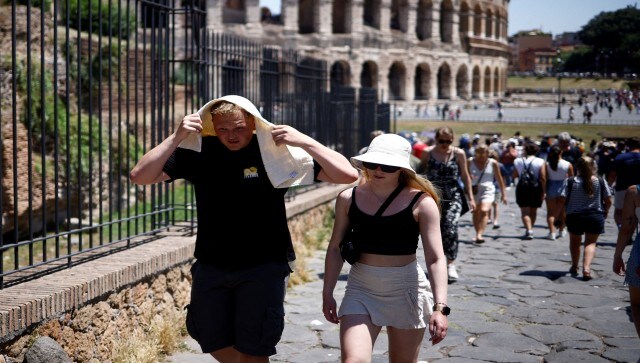Europe is sitting in the throes of a heatwave, with temperatures rising in major nations like Italy, Greece, and Spain. On Wednesday, the country experienced highs of 40 degrees Celsius, with forecasts for Sicily and Sardinia of up to 48 degrees Celsius, according to The Independent. Italy is currently in the critical zone, with the deadly “Cerberus” heatwave being blamed for the country’s first documented death. Health advisories have been issued for tourists in response to the lethal heatwave’s first fatality. But what exactly is Cerberus heatwave? How long will it last? Let’s take a closer look. Also read: Heat is On: How 3 July becomes the world’s hottest day and the worst is yet to come What is Cerberus heatwave? The deadly heatwave first got its name from Greek mythology, where Cerberus was possibly a three-headed monster dog guarding the gates of the underworld, reported Sky News. In Dante’s Inferno, Cerberus makes an appearance to watch over the third circle of hell.
Echidna is called the Mother of Monsters in Greek #mythology Hesiod described her as half beauty and half serpent beast, huge, brightly colored and voracious. Echidna gave birth to Cerberus and the Hydra, the Chimera and the Sphinx.#aMythForSunday #folklore #myths pic.twitter.com/EeprwbSi3d
— Arbeitskreis für Vergleichende Mythologie e.V. (@LE_Mythologie) January 26, 2020
Meteorologist Stefano Rossi told La Stampa, “Metaphorically, the three heads indicate the three main climatic zones into which Italy will be divided,” adding that the humidity would be “skyrocketing” and the overnight temperature wouldn’t fall below 22 degrees Celsius. The terrifying hellhound is frequently shown standing over flames. Also read: Burning Hot: These regions are likely to witness record-smashing heat waves Which areas are the hottest? In some areas of Spain, France, Greece, Croatia, and Turkey, temperatures are predicted to exceed 40 degrees Celsius. The highest recorded temperature in Italy was 48.8 degrees Celsius. Nimes, where a temperature of 35 degrees Celsius is expected, and Montpellier, where a temperature of 34 degrees Celsius is possible, will both experience extreme heat. On Saturday, Prague could experience highs of 34 degrees Celsius, compared to an average of 24 degrees. Temperatures in North Africa have been known to go as high as 50 degrees Celsius. Already, Tunisia has experienced temperatures that broke records, reaching as high as 49 degrees Celsius.
Heading on holiday soon?
— Met Office (@metoffice) July 12, 2023
🌡️ Heatwave conditions are continuing to affect parts of southwest Europe and northwest Africa, extending east through the week and peaking on Friday. pic.twitter.com/694gaMndRR
Maximum temperatures are predicted to reach 40 to 45 degrees Celsius in some areas of Sardinia, southern Italy, and mainland Greece, compared to an average of about 32 degrees Celsius. CNN quoted Luca Mercalli, head of the Italian Meteorological Society, as saying, “The earth has a high fever and Italy is feeling it firsthand.” A 44-year-old man was painting zebra crossing lines on Tuesday when he passed out, according to Italian media. He is claimed to have passed out owing to the extreme heat in the Italian town of Lodi, which is located outside of Milan. After being transferred to the hospital, he passed away. Italian politician Nicol Fratoianni tweeted, “We are facing an unbearable heatwave. Maybe it’s the case that in the hottest hours all the useful precautions are taken to avoid tragedies like the one that happened today in Lodi.” LBC reports that some visitors to the nation have already passed out from heat exhaustion, including a British guy in front of the Colosseum in Rome. It should be mentioned that Syracuse, Sicily, recorded the highest temperature in European history on 11 August 2021, reaching a high of 48.8C, as per The Independent. The heatwave this year, nevertheless, appears to surpass that mark as well. In 2022, Europe suffered the warmest summer on record, which was characterised by a flurry of intense heatwaves, disastrous droughts, and roaring forest fires. After last year’s record heatwave claimed more than 60,000 lives across the continent, the harsh weather is especially worrying. In 2022, when Europe saw the warmest summer on record, 61,672 people died as a result of the heat, according to a study published on Monday in Nature Medicine magazine. Also read: It’s not only India: How Asia is battling the ‘worst April heatwave’ How long will it last? The Saharan region’s high pressure is what’s causing the heat wave. [caption id=“attachment_12862552” align=“alignnone” width=“640”] Mathilde from France shelters from the sun with an umbrella near the Colosseum during a heatwave across Italy, in Rome. Reuters[/caption] According to The Guardian, in the middle and southern regions of Italy, the extreme heat is predicted to linger for nearly two weeks, while it will gradually abate in the north. What weather warnings have been issued? Numerous tourists in the Mediterranean are being urged to exercise additional caution due to the severe heat. Nine Italian cities, many of which are well-liked vacation destinations for British tourists, have issued severe weather advisories. According to Mirror.co.uk, these are Florence, Rome, Turin, Palermo, Bolzano, Frosinone, Perugia, Rieti, and Viterbo. Weather warnings have been issued for southern Spain, Italy, and France, and residents are encouraged to use caution when outdoors because temperatures are predicted to rise over 40C. The Red Cross has advised people to check on those who are most at risk, reported The Guardian. [caption id=“attachment_12862212” align=“alignnone” width=“640”]
 Temperatures are beginning to rise at the start of the second heatwave registered in Spain this summer. AP[/caption] Following a British tourist’s fall and fainting in Rome, people are being advised to drink plenty of water, avoid caffeine and alcohol, and watch out for indications of heatstroke. Elderly people, people with health issues, and people who live in exposed regions are particularly encouraged to be aware of the situation. Travel is advised only if necessary. A stark reminder Europe experiences record-breaking temperatures after the world saw the warmest days on record during the first week of July. The worrying highs are consistent with experts’ warnings about the continued use of fossil fuels, according to Professor Richard Betts, a climate scientist at the Met Office and the University of Exeter. BBC quoted him as saying, “This is all a stark reminder of what we’ve known for a long time, and we will see ever more extremes until we stop building up more greenhouse gases in the atmosphere.” [caption id=“attachment_12862542” align=“alignnone” width=“640”]
Temperatures are beginning to rise at the start of the second heatwave registered in Spain this summer. AP[/caption] Following a British tourist’s fall and fainting in Rome, people are being advised to drink plenty of water, avoid caffeine and alcohol, and watch out for indications of heatstroke. Elderly people, people with health issues, and people who live in exposed regions are particularly encouraged to be aware of the situation. Travel is advised only if necessary. A stark reminder Europe experiences record-breaking temperatures after the world saw the warmest days on record during the first week of July. The worrying highs are consistent with experts’ warnings about the continued use of fossil fuels, according to Professor Richard Betts, a climate scientist at the Met Office and the University of Exeter. BBC quoted him as saying, “This is all a stark reminder of what we’ve known for a long time, and we will see ever more extremes until we stop building up more greenhouse gases in the atmosphere.” [caption id=“attachment_12862542” align=“alignnone” width=“640”] A man shelters from the sun with a towel near the Colosseum during a heatwave across Italy, in Rome, Italy. Reuters[/caption] According to a number of studies, the human-caused climate catastrophe has increased the severity and frequency of heatwaves. Extreme temperatures have already been recorded this year in Asia, North Africa, and North America due to the start of El Nino, a weather phenomenon linked to increased warming. The World Meteorological Organisation of the United Nations predicted a rise in global temperatures, which is expected to last the remainder of the year. With inputs from agencies
A man shelters from the sun with a towel near the Colosseum during a heatwave across Italy, in Rome, Italy. Reuters[/caption] According to a number of studies, the human-caused climate catastrophe has increased the severity and frequency of heatwaves. Extreme temperatures have already been recorded this year in Asia, North Africa, and North America due to the start of El Nino, a weather phenomenon linked to increased warming. The World Meteorological Organisation of the United Nations predicted a rise in global temperatures, which is expected to last the remainder of the year. With inputs from agencies


)

)
)
)
)
)
)
)
)



